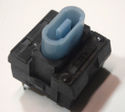NEC oval
 | |
| Manufacturer | NEC |
|---|---|
| Switch type | Clicky, linear |
| Sense method | Metal leaf |
NEC oval (provisional name) is a series of mechanical keyboard switches developed by NEC. It has been found in a few NEC keyboard models, most commonly the APC-H412.
Contents
Variants
Variants of the oval series include:
| Colour | Type | |
|---|---|---|
 |
Blue | Clicky |
| Heavy Blue | Clicky | |
 |
Cream | Linear |
| White | Linear | |
| Heavy White | Linear | |
| Black | Linear | |
| Lock | Alternate Action |
Blue
The blue switch is distinctive not only because of its oval shape, but because it is one of only a few types of mechanical switches that actuate before their click and tactile response occur (see force measurements, below).
In the APC-H412, the switch emits a characteristic ping upon bottoming out. In theory, the ping's frequency is at the resonant frequency of its spring, which may be somewhat loose in the key's resting position. Thus, bottoming out a key, or releasing it quickly, sends an impulse through the board that elicits the impulse response of a spring: vibration at its natural frequency. With multiple springs responding at different amplitudes, the whole board "sings".
Provisional force measurements are as follows:
- 45-50 g force, 2.5 mm travel - actuation
- 70-75 g force, 3.0 mm travel - click, tactile response
- 4.0 mm travel - bottoming out
Removing keycaps
The "normal" method of pulling a keycap can damage this switch. The switch's plastic top plate, which holds it together, is extremely thin. If you pull straight up, and the key is stuck in any way (easily true for a dirty switch), the force required to free the cap will break the top plate and everything will fall apart. Instead:
- Grab both sides of the key with a Topre-style keycap puller.
- With the puller vertical and perpendicular to the keyboard, rotate it to the right. The left edge of the keycap rises and the right edge either stays in place or drops.
Once the cap is removed, applying a lubricant such as Finish Line Extreme Fluoro between the keycap and slider makes it easier to pull them apart in the future.
Removing switches
The switch seems to be held in place by two solder joints, but removing these joints allows only the switch plate to come loose. The switch body is held in place by two extremely thin tabs. If you try to remove them, they break. (OP: I've already destroyed one switch this way; it will not mount again.) To remove the switch body, it's necessary to detach the mounting plate from the PCB, to which it's attached by several metal rivets.
Keyboards
- NEC APC-H412 (Blue, Clicky)
- NEC PC9801V[1] (Cream, Linear)
Gallery
Blue
External links
- Deskthority – NEC blue ovals
- Geekhack – NEC APC H-412 keyboard
- Sandy – NEC switch
- YouTube – NEC APC-H410E Blue Oval Key Switch Removal
References
- ↑ YouTube – Typing sounds of NEC linear oval switches - NEC PC9801V keyboard Uploaded 2019-04-14.






